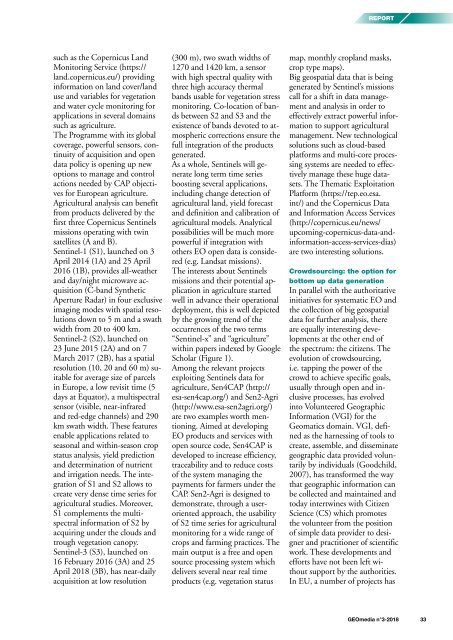GEOmedia_3_2018
GEOmedia - the first Italian magazine on geomatics
GEOmedia - the first Italian magazine on geomatics
You also want an ePaper? Increase the reach of your titles
YUMPU automatically turns print PDFs into web optimized ePapers that Google loves.
REPORT<br />
such as the Copernicus Land<br />
Monitoring Service (https://<br />
land.copernicus.eu/) providing<br />
information on land cover/land<br />
use and variables for vegetation<br />
and water cycle monitoring for<br />
applications in several domains<br />
such as agriculture.<br />
The Programme with its global<br />
coverage, powerful sensors, continuity<br />
of acquisition and open<br />
data policy is opening up new<br />
options to manage and control<br />
actions needed by CAP objectives<br />
for European agriculture.<br />
Agricultural analysis can benefit<br />
from products delivered by the<br />
first three Copernicus Sentinels<br />
missions operating with twin<br />
satellites (A and B).<br />
Sentinel-1 (S1), launched on 3<br />
April 2014 (1A) and 25 April<br />
2016 (1B), provides all-weather<br />
and day/night microwave acquisition<br />
(C-band Synthetic<br />
Aperture Radar) in four exclusive<br />
imaging modes with spatial resolutions<br />
down to 5 m and a swath<br />
width from 20 to 400 km.<br />
Sentinel-2 (S2), launched on<br />
23 June 2015 (2A) and on 7<br />
March 2017 (2B), has a spatial<br />
resolution (10, 20 and 60 m) suitable<br />
for average size of parcels<br />
in Europe, a low revisit time (5<br />
days at Equator), a multispectral<br />
sensor (visible, near-infrared<br />
and red-edge channels) and 290<br />
km swath width. These features<br />
enable applications related to<br />
seasonal and within-season crop<br />
status analysis, yield prediction<br />
and determination of nutrient<br />
and irrigation needs. The integration<br />
of S1 and S2 allows to<br />
create very dense time series for<br />
agricultural studies. Moreover,<br />
S1 complements the multispectral<br />
information of S2 by<br />
acquiring under the clouds and<br />
trough vegetation canopy.<br />
Sentinel-3 (S3), launched on<br />
16 February 2016 (3A) and 25<br />
April <strong>2018</strong> (3B), has near-daily<br />
acquisition at low resolution<br />
(300 m), two swath widths of<br />
1270 and 1420 km, a sensor<br />
with high spectral quality with<br />
three high accuracy thermal<br />
bands usable for vegetation stress<br />
monitoring. Co-location of bands<br />
between S2 and S3 and the<br />
existence of bands devoted to atmospheric<br />
corrections ensure the<br />
full integration of the products<br />
generated.<br />
As a whole, Sentinels will generate<br />
long term time series<br />
boosting several applications,<br />
including change detection of<br />
agricultural land, yield forecast<br />
and definition and calibration of<br />
agricultural models. Analytical<br />
possibilities will be much more<br />
powerful if integration with<br />
others EO open data is considered<br />
(e.g. Landsat missions).<br />
The interests about Sentinels<br />
missions and their potential application<br />
in agriculture started<br />
well in advance their operational<br />
deployment, this is well depicted<br />
by the growing trend of the<br />
occurrences of the two terms<br />
“Sentinel-x” and “agriculture”<br />
within papers indexed by Google<br />
Scholar (Figure 1).<br />
Among the relevant projects<br />
exploiting Sentinels data for<br />
agriculture, Sen4CAP (http://<br />
esa-sen4cap.org/) and Sen2-Agri<br />
(http://www.esa-sen2agri.org/)<br />
are two examples worth mentioning.<br />
Aimed at developing<br />
EO products and services with<br />
open source code, Sen4CAP is<br />
developed to increase efficiency,<br />
traceability and to reduce costs<br />
of the system managing the<br />
payments for farmers under the<br />
CAP. Sen2-Agri is designed to<br />
demonstrate, through a useroriented<br />
approach, the usability<br />
of S2 time series for agricultural<br />
monitoring for a wide range of<br />
crops and farming practices. The<br />
main output is a free and open<br />
source processing system which<br />
delivers several near real time<br />
products (e.g. vegetation status<br />
map, monthly cropland masks,<br />
crop type maps).<br />
Big geospatial data that is being<br />
generated by Sentinel’s missions<br />
call for a shift in data management<br />
and analysis in order to<br />
effectively extract powerful information<br />
to support agricultural<br />
management. New technological<br />
solutions such as cloud-based<br />
platforms and multi-core processing<br />
systems are needed to effectively<br />
manage these huge datasets.<br />
The Thematic Exploitation<br />
Platform (https://tep.eo.esa.<br />
int/) and the Copernicus Data<br />
and Information Access Services<br />
(http://copernicus.eu/news/<br />
upcoming-copernicus-data-andinformation-access-services-dias)<br />
are two interesting solutions.<br />
Crowdsourcing: the option for<br />
bottom up data generation<br />
In parallel with the authoritative<br />
initiatives for systematic EO and<br />
the collection of big geospatial<br />
data for further analysis, there<br />
are equally interesting developments<br />
at the other end of<br />
the spectrum: the citizens. The<br />
evolution of crowdsourcing,<br />
i.e. tapping the power of the<br />
crowd to achieve specific goals,<br />
usually through open and inclusive<br />
processes, has evolved<br />
into Volunteered Geographic<br />
Information (VGI) for the<br />
Geomatics domain. VGI, defined<br />
as the harnessing of tools to<br />
create, assemble, and disseminate<br />
geographic data provided voluntarily<br />
by individuals (Goodchild,<br />
2007), has transformed the way<br />
that geographic information can<br />
be collected and maintained and<br />
today intertwines with Citizen<br />
Science (CS) which promotes<br />
the volunteer from the position<br />
of simple data provider to designer<br />
and practitioner of scientific<br />
work. These developments and<br />
efforts have not been left without<br />
support by the authorities.<br />
In EU, a number of projects has<br />
<strong>GEOmedia</strong> n°3-<strong>2018</strong> 33


















